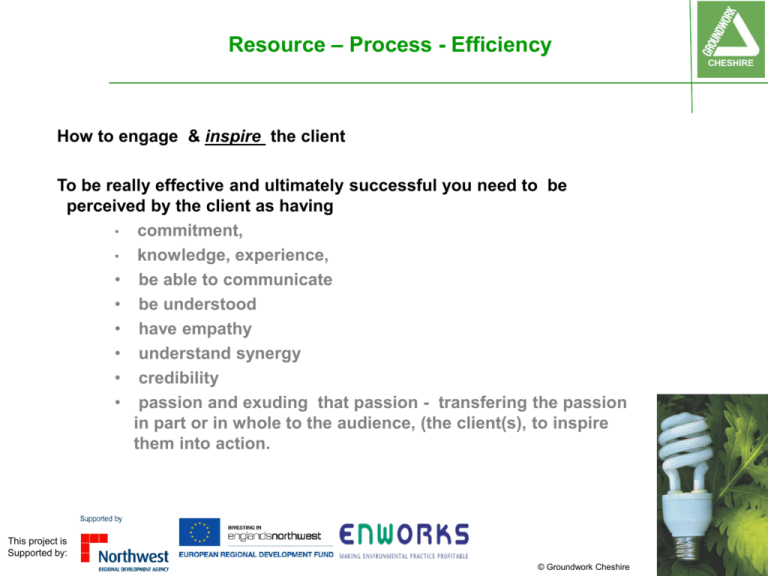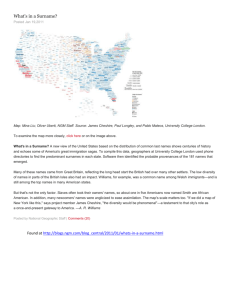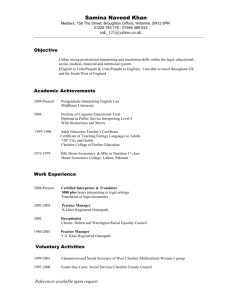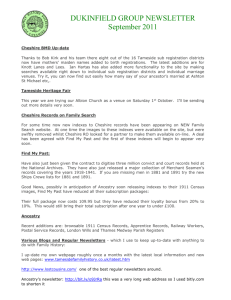Process Efficiency
advertisement

Resource – Process - Efficiency How to engage & inspire the client To be really effective and ultimately successful you need to be perceived by the client as having • commitment, • knowledge, experience, • be able to communicate • be understood • have empathy • understand synergy • credibility • passion and exuding that passion - transfering the passion in part or in whole to the audience, (the client(s), to inspire them into action. This project is Supported by: © Groundwork Cheshire Process Efficiency So how do you do this? DEMONSTRATE AND SUPPORT THE POTENTIAL TO PROVIDE COST SAVINGS!!!!!! This project is Supported by: © Groundwork Cheshire What needs to be improved • Identifying what needs to be improved is always helpful ie some companies have the mission statement, some companies lead times ;some service levels. • Companies tend to relate back to the financial plan with some non financial targets such as complaints, customer ppm, hours without a lost time accident etc. • These targets are then communicated through to all and action the team through policy deployment. This allows activities to be tested on the question- does project X support any of the critical objectives?. This project is Supported by: © Groundwork Cheshire Process Efficiency Need to know what, where and how resources are used in the process and controls in place – – – – – – – – Do they have recognised Management procedures eg ISO Is the process(es) a batch process or continuous or a mixture Do they recognize and apply best practice man machines methods and materials? Are there perceived bottlenecks, pinch points, rate determining steps in the process Raw materials - records of amounts purchased/used, rejects &rework (plus analysis), complaints. Costs of major raw materials. QA records Energy & water- Bills, any monitoring and targeting, any analysis – major consumers of utilities Waste- how/where it arises - the amounts- is it avoidable and if unavoidable is it being managed? Transport- Systematic approach, logs of fuel use, training This project is Supported by: © Groundwork Cheshire Process Efficiency Input 100% Process(es) Output 70% Difference 30% HOW, WHY ,WHERE ,WHO,WHAT This project is Supported by: © Groundwork Cheshire Where to start! • “If you can’t measure it, you can’t control it. • If you can’t control it, you can’t improve it.” This project is Supported by: © Groundwork Cheshire Effective use of Short Interval Control (SIC) can be summarized in this way • Processes are kept in control when - and only when - every member of the organisation accepts responsibility for identifying variances, then takes action to eliminate causes of problems. This project is Supported by: © Groundwork Cheshire Some Basic and not so Basic Problem Solving Tools • Brainstorming • 5s – Sort-Set in order- Shine- Standardise- Sustain • Histograms & Charts • Process-Mapping • Fishbone (Ishikawa) Diagrams • Mapping – Visual - waste • Causal-Loop Diagram • Pareto Diagrams • Attribute Charts • • • • • • Route Cause Analysis Statistical Process Control – 6 sigma – Capability SMED Design of Experiments Taguchi Multi variable SPC • Some tools are for driving improvements whilst the others are to stabilise the new state and managing abnormalities. This project is Supported by: © Groundwork Cheshire The Power of “Why The most powerful question a consultant can ask is: WHY? … ask enough times and you will uncover the root cause. This project is Supported by: © Groundwork Cheshire Why Is The US Railroad Gauge 4’ 8.5”? • • • • • • Why? Because that's the way they built them in England. Why did the English build them like that? Because the first rail lines were built by the same people who built the pre-railroad tramways. Why did they use that gauge then? Because the people who built the tramways used the same jigs and tools that they used for building wagons, which used that wheel spacing. Why did the wagons have that particular odd wheel spacing? Well, if they tried to use any other spacing the wagon wheels would break on some of the old, long distance roads in England, because that's the spacing of the wheel ruts. So who built those old rutted roads? The first long distance roads in Europe (and England) were built by Imperial Rome for their legions - Roman war chariots first made the initial ruts, which everyone else had to match for fear of destroying their wagon wheels and wagons. Why were the chariots designed as they were? Imperial Roman war chariots were made just wide enough to accommodate the back ends of two war horses This project is Supported by: © Groundwork Cheshire Why Is The US Railroad Gauge 4’ 8.5”? Because that is the width of the backend of two horses! This project is Supported by: © Groundwork Cheshire Definition: KPI • A Key Performance Indicator (KPI) is a metric which is used to measure the performance of a critical or high leverage activity or process This project is Supported by: © Groundwork Cheshire Definition: KPI KPI’s are like the dashboard of a car. They provide the essential information required to control the vehicle safely and efficiently. They do not provide information on all of the aspects of the vehicle which could be measured This project is Supported by: © Groundwork Cheshire Make sure you measure the right thing • The FAA defines ‘on time departure’ as when the door shuts • …Not much fun if you’re a passenger delayed on the runway for another hour This project is Supported by: © Groundwork Cheshire Use both ‘Leading’ and ‘Lagging’ indicators Example When losing weight, it is far more effective to count calories than to just focus on weight Leading indicators measure activity (input) while the lagging indicators measure results (output) This project is Supported by: © Groundwork Cheshire Map the KPI relationships using a tree Lagging $ / Unit Leading Units Efficiency Yield Cost $ Materials Labor • KPI tree cascades each of the desired outcomes to the lowest level at which a KPI can be managed This project is Supported by: © Groundwork Cheshire Example of a KPI tree Variable Cost Throughput Efficiency Process Control Availability Changeovers Stoppages Quality Give-Away / Breakages Energy Efficiency Fixed Cost Labor Productivity Overtime / Contractors Staffing / Shifts Materials Usage Org.Effectiveness Infrastructure Warehouse Inventory This project is Supported by: © Groundwork Cheshire Set challenging goals •Until Roger Bannister broke the fourminute mile, it was commonly believed that it could not be done •After he broke the record, suddenly others began to be able to accomplish this as well Why is that? This project is Supported by: © Groundwork Cheshire Targets, budgets, plans, etc. • *B.D.P. = Best Demonstrated Practice Plan KPI Actual B.D.P.* Target Budget Base This project is Supported by: © Groundwork Cheshire Define ‘SMART’ Targets S Specific M Measurable A Achievable R Realistic T Time Related This project is Supported by: © Groundwork Cheshire KPI guidelines • • • • Should be limited to manageable number (12-25) Should be used in balanced combinations or as ratios Should be measured against a base, plan and target Should be capable of being influenced by the person monitoring it • Should be used as a tool to improve performance and not to punish poor performance • Should be easy to understand This project is Supported by: © Groundwork Cheshire The D.A.D.A. Cycle Data Action Facts Analyse Decision This project is Supported by: © Groundwork Cheshire Stages In The Process • Identify problems • Record them • Classify or group them • Agree ranking criteria • Rank and prioritise problems This project is Supported by: © Groundwork Cheshire Basic Problem Solving Tools • Brainstorming • Histograms & Charts • Process-Mapping • Fishbone (Ishikawa) Diagrams • Mind-Mapping • Causal-Loop Diagram • Pareto Diagrams This project is Supported by: © Groundwork Cheshire Example: Pareto (80/20 Rule) 98% 95% 46 100% 45 90% 83% 40 80% 71% 35 Frequency 100% 90% 70% 30 60% 46% 25 25 50% 20 40% 15 30% 12 10 7 5 5 Cummulative % 50 20% 3 2 0 10% 0% 1 2 3 4 5 6 7 Category This project is Supported by: © Groundwork Cheshire Example: Fishbone (Ishikawa) Diagram Cause Effect Men Machines EFFECT 4 P’s Policies Plant People Procedures Methods Materials This project is Supported by: © Groundwork Cheshire Introduction of the root cause analysis (RCA) • Definition – Root Cause Analysis (RCA) is a formal approach to solving a given problem – The use of RCA provides a structured method for developing the root cause and enables identification of the best recommended solutions to the problem • When is a RCA needed? – Any time there is an incident, or when you have identified a repetitive problem that needs to be solved • Who can use the RCA method? – Everyone This project is Supported by: © Groundwork Cheshire Root cause analysis in 5 steps Defi ne the pro ble Step n°1:m agreement and scope problem. Collect data to establish a hypothesis, idea or theory of what happened once the problem is defined. Elements/Tools Elements/Tools Problem Statements Det erm ine data nee Step n°2: ds Timelines Data collection plan Prove the hypothesis by taking the large list of potential causes and identifying the most likely root cause(s) Ishikawa Flowcharts/ Process Maps Ishikawa Diagrams Imp lem ent solu tion Step n°5:s Acti Step n°4:ons Generate a list of Ensure improvements to recommendations are address root causes implemented through of the identified issues assigning responsibilities to stakeholders and following up in RCA Meetings Elements/Tools Elements/Tools Assign Actions Team Authorization Define responsible entity and timeline Pareto Charts Flowchart/ Process Maps Prioritize (risk rank) task Risk Analysis FMEA Submit to RCA Team Pareto Charts Eliminate and rank causes Affinity diagram Corr ecti ves Elements/Tools Collecting Data Boundaries Improvement Targets Anal yse the pro ble Step n°3: m Follow up Resource Evaluation Communicate Results This project is Supported by: © Groundwork Cheshire Ishikawa example METHODS Causes MACHINERY Use wrong gears Drive too fast Poor hearing Fuel mix too rich No record tire pressure Under-inflated tires Mech. doesn’t Radio too loud have specs Always late Impatience Poor maintenance $ Poor design Can’t hear engine Carburetor adjustment Poor training Difficult air valve stems Wrong gas type MANPOWER Poor driving habits $ Don’t know recommended petrol type Causes Represented by the RIBS of the skeleton Use the “4M’s” / “4P’s” or others to categorize the causes Add the causes to the rib Add further riblets to show relationships between causes POOR GAS MILEAGE No oil change No owner’s “When in Rome”manual No awareness Effects Improper lubrication Don’t know right oil Wrong oil No owner’s manual MATERIALS Effects This project is Supported by: © Groundwork Cheshire CAUSE & EFFECT DIAGRAM reminders • • • • • “4 M’s” Manpower Machinery Materials Methods “4 P’s” Personnel Plant Policies Procedures This project is Supported by: © Groundwork Cheshire Affinity diagram Étape 1 Brainstormed Post-Its Stick with the rule of 3 - 6 words per Post-It, with a verb. Define the categories This project is Supported by: © Groundwork Cheshire Root Cause Analysis Roadmap Define Problem Suppliers Inputs Process Outputs Customers Problem Statement: Goal: Business Case: Scope: Targeted improvement Timeline:: Determine Data Needs Analyze Data 80,000 70,000 60,000 50,000 40,000 Total 30,000 20,000 10,000 0 0020 Arret Scie (Detection Genoux) 0001 Bp Arret Urgence 4pc12-2 0099 Trappe A Faute 0009 Convoyeur De Compression Pas Baissee 0004 Blocage Entrée Courroie Action log Corrective Action Implementation 1 2 3 4 5 6 7 8 9 10 A B C D G E F H G I This project is Supported by: © Groundwork Cheshire J Supported by coaching the people in using specific tools... Helping the people utilise the new measurements properly “these tools can eventually be automated to help people think and make decisions faster” Source fishbone Root-cause fishbone Frequency histogram Pareto histogram 3 Decision scripts This project is Supported by: © Groundwork Cheshire Short Interval Control (SIC) Prevents Large Problems from Surprising the Organization This project is Supported by: © Groundwork Cheshire What is a Short Interval Control (SIC)? • SIC is part of a suite of tools to improve the efficiency of production focusing on a part of a process that is critical to the overall optimisation of the process • A tool tracking a variable at the optimum interval. This variable will be whatever is most meaningful in optimising output and the reporting will be based on a variance against a standard. • Typically developed and used by the people at the ‘front line’ of the process and recorded by hand. High performance results are achieved where the operator has the desire & passion to achieve the best results and quickest resolution of issues – thus behaviours are very important. • Provides a good base for communication tool between operators on shift change This project is Supported by: © Groundwork Cheshire Designing the Short Interval Control (SIC) – What are the principles? • Find or develop experts who know about process control charts. • ‘Get them to do it!’ - Coach the operators through drawing up the control chart, identifying the appropriate interval for measuring the variable, and establishing the desired parameters for operation (across shifts!). • Don’t design the ‘perfect’ control chart - go with one that does the job; upgrade at a later date • Make a commitment to reviewing the performance regularly and consistently This project is Supported by: © Groundwork Cheshire Coaching the Installation of a SIC Working with Operators, define key variables to monitor Agree performance standard Coach operators in designing SIC Get operators to agree on targets / parameters; communicate across shifts Set aside several hours each day to sit with operators to install SIC Challenge Listen / Follow up Support / Trust Question operating norms, changes to rates, challenge non-compliance, reward good operation, use problemsolving tools to help remedy poor operation - LISTEN This project is Supported by: © Groundwork Cheshire Short Interval Control Tool • Short Interval Control (SIC) mechanism is a simple tool • Helps staying on track towards goal • SIC is utilizing the decision loop so frequently that any deviation from progress towards goal is DATA corrected early enough (Check) ANALYSIS (Act) ACTION (Do) This project is Supported by: DECISION (Plan) © Groundwork Cheshire Description of Short Interval Control Short interval control (SIC) 3-4-5 Line: Follow: What is SIC? SIC is used to measure shortterm changes in the process. It serves as a tool for communicating processperformance during team changes. It is a tool that ensures corrective actions are taken before the process goes out of control. Palletiser Place: (Follow every hour) Follows the number of stops in minutes on the palletiser after accumulation or bad pallets 25 min 20 min 15 min 10 min 5 min 0 Number of the pallatiser Time 6 AM 7AM 8AM 9AM 10AM 11AM 12AM 1PM 2PM 3PM 4PM 5PM 6PM 7PM 8PM 9PM 10PM 11PM 12PM 1AM 2AM 3AM 4AM 5AM • If the indicator is in the red zone, the process is out of control. Take corrective action. Call the supervisor. • If the indicator is in the yellow zone, take preventive measures to avoid the process going out of control. • Check the adjustments or call the supervisor, electrician, mechanic. • If the indicator is in the green zone, the process is under control Congratulations! This project is Supported by: © Groundwork Cheshire Example of Graphical SIC Short Interval Control (Example) Line: Area: 5 Follow: Shift 10 min Shift Corrective Action Shift Corrective Action 8 min Corrective Action tendency increasing 6 min Preventive Action Preventive Action 4 min 2 min 0 Operator Initials Time 6 AM 7AM 8AM 9AM 10AM 11AM 12AM 1PM 2PM 3PM 4PM 5PM 6PM 7PM 8PM 9PM 10PM 11PM 12PM 1AM 2AM This project is Supported by: © Groundwork Cheshire 3AM 4AM 5AM What’s SMED? Single Minute Exchange of Dies CYCLE TIME COMPRESSION AND IMPROVEMENT IN QUALITY This project is Supported by: © Groundwork Cheshire PIT CREW • • • Tyres ready, tools in place, fast-flow fuel tank is full Co-ordinated crew activity four new tyres - fill fuel tank wipe windshield - water for driver Car out of pit - get ready for next pit stop This project is Supported by: © Groundwork Cheshire IMPROVEMENTS IN PIT STOP TIMES TIME IN SECONDS 250 200 150 100 50 0 1950 1960 1970 1980 1990 YEAR This project is Supported by: © Groundwork Cheshire Definition of changeover time The time, the last good product was produced on the old setup, to the time, the first acceptable product is made on the new set-up (after adjustments).” This project is Supported by: © Groundwork Cheshire CAUTION - What is the changeover time? • to external changeover last good piece of old product internal activity changeover rework first pass yield start of first good piece of new product re set-up during process of part This project is Supported by: © Groundwork Cheshire Parallel Operations This project is Supported by: © Groundwork Cheshire How can adjustment time be eliminated? Externals Externals Internals Internals Run Run This project is Supported by: © Groundwork Cheshire Smooth & Simplify • Eliminate adjustments - standardize location points, settings of adjustment, utilize visible centerlines and numerical scales • Use functional clamps and one-turn, one-motion, interlocking methods • Determine the best way to organize, maintain, and store tools and materials. • Determine the right amount of tools and materials. – And... This project is Supported by: © Groundwork Cheshire Smooth & Simplify • • • • • “Slick” loading and unloading of dies and fixtures Determine and record key dimensions Utilize a least common multiple system De-skill most steps Utilization of appropriate technology - standard base plates, chamfered pins, t bolts, v fixtures, limit switches to set heights and lengths, upgraded clamping methods • Mechanize - utilize forklifts, overhead cranes, bolsters, remote control tightening devices, electric drives This project is Supported by: © Groundwork Cheshire BENEFITS of SMED • • • • • • • • • • • • • • • Quicker set-ups - reduced downtime Increased uptime - increased production and throughput Higher equipment availability Improved competitiveness - job security Improved safety - reduced risk of injury & physical strain Improved customer service and delivery Reduced costs and improved quality Reduced lot sizes Reduced scrap and repair Reduced work in process inventory (WIP) Reduced finished goods inventory / need for storage space Reduced obsolescence Improved housekeeping Simplified production scheduling Increased manufacturing flexibility This project is Supported by: © Groundwork Cheshire SMED do’s and don’ts DO • Start on bottlenecks • Reduce batch sizes in line with set-up reductions • Organize the workplace • Make checklists • Focus on internal set-ups first • Eliminate / reduce adjustments • Develop one-touch clamping • Utilize fool-proofing • Standardize methods This project is Supported by: © Groundwork Cheshire SMED do’s and don’ts DON’T • Tackle all machines / products at once • Underestimate time required • Expect instant results This project is Supported by: © Groundwork Cheshire What is a One Point Lesson? • It is a short Standard Operating Procedure (SOP) with visual elements written in one page • It is a tool to communicate knowledge and skill about the equipment amongst members of the team. • A tool to raise the knowledge and skills of the team in a very short period of time. • If you find a better way of doing something you can ensure that everyone knows about it by using a One Point Lesson (OPL). • If you have found a way of solving a problem and want to ensure that next time the problem is encountered everyone knows, then tell the team using an OPL (but also update the correlated SOP This project is Supported by: © Groundwork Cheshire What is a One Point Lesson? • A One Point Lesson is one of the easiest and cheapest methods of reducing and avoiding downtime. • It is a complement for the SOP in order to facilitate the communication and the training. • One Point Lesson NEVER REPLACE THE SOP This project is Supported by: © Groundwork Cheshire How is a One Point Lesson generated? • One member of the team prepares a sheet, which describes the problem and solution in simple language. Illustrate it with pictures if possible. • The team discusses the OPL, formally or informally, and incorporate any ideas. • The OPL is approved by line management to ensure it is appropriate and safe. • The OPL is published and read by all members of all shift teams. Individuals sign to acknowledge that they have read the OPL. This project is Supported by: © Groundwork Cheshire The One Point Lesson Form (Example This project is Supported by: © Groundwork Cheshire How to achieve Behavioral Ownership • Create a sense of urgency so that people start telling each other, “Let’s go, we need to change things!” • Pull together a guiding team powerful enough to guide a big change • Create clear, simple, uplifting visions and sets of strategies • Communicate the vision through simple, heart felt messages sent through multiple channels so that people begin to buy into the change • Empower the people by removing obstacles to the vision • Create short-term wins that provide momentum • Maintain momentum so that wave after wave of change is possible • Make change stick by nurturing a new culture This project is Supported by: © Groundwork Cheshire






